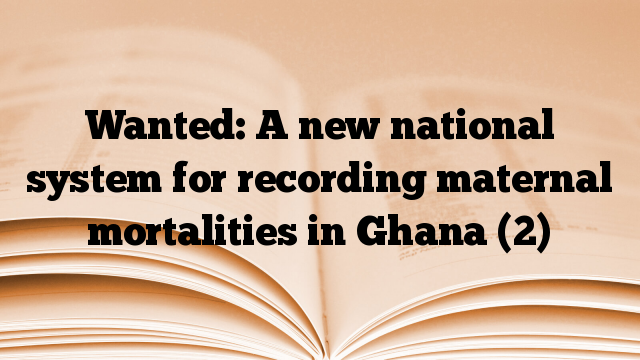Saturday, April 23, 2022.
In my first piece, I wrote:
What new system of recording maternal mortality do I propose? An audit team from both referring and receiving institutions must audit these mortalities as much as possible. If the conclusion is that there is no way the receiving institution could have prevented the mortality, it should reflect in the reporting system. The referring institution should also have a record of this maternal mortality. So in this case, if Catholic Hospital, Battor had 2 institutional maternal mortalities before this patient came to die, the record of Catholic Hospital, Battor will be 3 – 1 (3 minus 1). If the referring institution did not have a maternal mortality before this death, its record will be 0 + 1 (0 plus 1).
When we do this, at a glance we can have an idea about the institutions that are recording maternal mortalities in Ghana, as well as the institutions that are not recording maternal mortalities but referring patients to die in other institutions. Then we shall know where to direct resources to prevent maternal mortalities. We can extend this to neonatal mortalities and others. We need reliable data to solve our problems.
The above is actually a simplified version of my proposed national recording of maternal mortalities. The complete record for every institution in the country has to be in the form A-B-C-D. This will be similar to what is used in boxing to summarise the record of boxers.
In boxing, if Strongman Kofi Vandidi Bawus has a career record of “38-4-1-2” it means he had “38 Wins, 4 Losses, 1 Draw, 2 No Contests.”
For this proposed A-B-C-D national recording of maternal mortalities:
‘A’ represents the total number of mortalities recorded in an institution (including those for which the patient spent just 10 seconds in the institution).
‘B’ represents the ‘minuses’ mentioned – the number of maternal mortalities the institutions had which (after audits) became clear that they should not be the responsibility of the institution but rather of a referring institution (that probably referred just to have a zero maternal mortality).
‘C’ represents the ‘pluses’ mentioned – the number of patients the institution referred to another facility that ended up as maternal mortalities for which (after audits) the receiving institution is not responsible.
‘D’ represents the number of women who were ‘brought in dead (BID)’ to the institution.
So a maternal mortality record of 8-3-2-1 for Hospital X means there was a total of 8 maternal deaths in Hospital X, three (3) of them were mortalities Hospital X could have done nothing about (so are ‘attributed’ to another institution). Hospital X also referred 2 patients to another institution that resulted in maternal mortalities (for which the receiving institutions could have done nothing about). Then there was one (1) maternal mortality for which the woman was brought in dead to Hospital X.
This recording system will capture all maternal mortalities in the country (including those brought in dead) and lead to more communication between referring and receiving institutions.
We cannot do the same things we have done in the past and expect to achieve different/better results. Change begins with you and me.
Dr. Kofi Effah is an Obstetrician Gynaecologist in Catholic Hospital, Battor in the North Tongu District of the Volta Region of Ghana.


I have read your write up on reporting on maternal mortality records in Ghana today.
The piece is very insightful and makes sense in making sure that both the referring and receiving health institutions are accountable for the care of patients. That way the receiving institutions will stop blaming referring centres for cases who they could have easily saved but bungled up. The referring institutions will now show much responsibility in managing cases and sending them over timely when it is clear the institutions can’t handle the case. Sometimes it should even start from Antenatal care, was the clinic competent to manage such patients who may have had identifiable risk factors etc.
I know a government facility who almost always refer their serious emergencies on weekends. When we followed up , apparently the OBGYNs were not available weekends and that explained why women were sent to other institutions during weekends.
I believe getting to use this system will help in solving some of the delays expectant moms and family face in seeking Obstetric emergency healthcare in Ghana.
Thank you 🙏🏾
Dr Francis Bitasimi Bilson